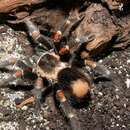en
names in breadcrumbs


The spider family Theraphosidae (tarantulas) includes 947 described species (Platnick 2014), including around 55 species in North America north of Mexico (Prentice 2005). In North America, the native species, all in the genus Aphonopelma, occur west of the Mississippi River from the southern border of the United States north to the approximate midline through Missouri, Kansas, and Colorado and somewhat farther north in Utah, Nevada, and California. In addition, Brachypelma vagans has been introduced to Florida and appears to be established there (the native range of this species is from Veracruz and the Yucatán Peninsula in Mexico south along the Gulf Coast to Costa Rica). (Edwards and Hibbard 1999; Prentice 2005). Prentice (2005) notes that Aphonopelma is in need of revision and that the list of species known from the United States probably currently includes many synonyms (e.g., see Wilson et al. 2013; Nentwig 2012 provides one example of the trouble arising from taxonomic confusion in this group) . On the other hand, it seems clear that there are many unrecognized Aphonopelma species (Hamilton et al. 2011; Hendrixson et al. 2013).
Members of both Aphonopelma and Brachypelma live in subterranean burrows. There is no door-like closure at the burrow entrance, but the entrance is often lined with silk. The resident tarantula may keep the entrance covered with a thin silk sheet during the day; the burrow entrance is often plugged with soil during periods of inactivity such as in the winter and, in more arid areas, during the hot summer. When open, the visible silk lining of the burrow entrance helps distinguish these large burrows from those of other animals. (Prentice 2005; Bradley 2013)
Tarantulas are large, pubescent ("downy") mygalomorph spiders with two tarsal claws and, typically, claw tufts on each tarsus (but see Pérez-Miles and Weinmann 2010 and references therein). In most New World tarantulas, there are urticating hairs on the upper rear of the abdomen, whose function has been examined by Bertani and Guadanucci (2013). The chelicerae are robust, especially in females. Tarantulas are nocturnal sit-and-wait predators, rarely found more than a few centimeters from their burrow entrances. Captive Aphonopelma females of several species have matured at a minimum of seven years of age; females continue to molt (often irregularly with increasing age) throughout their lives. After maturity, females continue to live in their burrows, but males wander in search of females to mate with and generally die shortly thereafter. In captivity, individuals of several Aphonopelma species have lived more than 30 years. Mating activity of fall breeding species is generally inhibited when nighttime temperatures drop below 15 C (60 F) and daytime temperatures are above 26 C (80 F). Mating activity of summer breeding species occurs almost exclusively after sunset because of high daytime temperatures.(Prentice 2005)
Machkour-M'Rabet and colleagues assessed the impact of habitat fragmentation on Brachypelma vagans and concluded that, in the case of this particular species in the Mexican Caribbean, human activities have actually had a net positive impact on populations (Machkour-M'Rabet et al. 2012 and references therein).
Although bites from tarantulas rarely produce serious adverse reactions in humans, even quite large dogs have been reported to die after being bitten (Isbister et al. 2003; O'Hagan et al. 2006). Krug and Elston note that for humans, the greatest danger posed by New World tarantulas is generally the defensive barbed urticating hairs that tarantulas of many species can release when threatened, with the greatest threat of serious consequences if these hairs enter the eye; the venom of Old World tarantulas generally produces more serious symptoms in humans than does the venom of New World species (Krug and Elston 2011 and references therein).